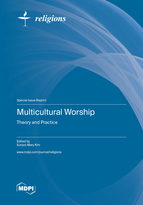Multicultural Worship: Theory and Practice
A special issue of Religions (ISSN 2077-1444). This special issue belongs to the section "Religions and Theologies".
Deadline for manuscript submissions: closed (31 December 2021) | Viewed by 21459
Special Issue Editor
Interests: multiculturalism; Christian preaching; Christian worship; postcolonialism
Special Issues, Collections and Topics in MDPI journals
Special Issue Information
Dear Colleagues,
We live in an unprecedently globalized multicultural world in the 21st century. Christian churches and worship leaders are challenged to be conscious of the significant impact of multiculturalism within and beyond the church and provide worshipers with theologically faithful and culturally appropriate worship services. As a response to these challenges, this Special Issue deals with various multicultural issues emerging from contemporary liturgical contexts: What is multicultural worship? Why should Christian worship be multicultural? How can multicultural worship be designed to be relevant to a particular liturgical context? How can liturgical elements (e.g., worship space, symbols, language, sermons, prayers, music, and sacraments) be prepared from the multicultural perspective? This Special Issue aims to help worship leaders and scholars explore these questions and develop their theology and method of multicultural worship.
The scope of this Special Issue includes five areas: (1) worship in multiracial or multiethnic contexts; (2) worship in monoracial or monoethnic contexts; (3) worship in multigenerational contexts; (4) worship in ecumenical contexts; and (5) worship in multireligious contexts. You are invited to write an article focusing on one of these areas with a critical analysis of the current practice of worship in that area. For example, you may choose area (1) and investigate what is going on in worship among multicultural congregations and interpret why this is going on. You are also expected to articulate a theology of multicultural worship in terms of its nature, purpose, and character appropriate to multicultural congregations and propose creative liturgical ideas and strategies for the practice of multicultural worship in a particular liturgical context. In addition, a sample liturgy with annotations that call attention to distinctive liturgical characteristics and explanations about the specific liturgical context and theme should be attached to your article. Biblical, historical, socio-cultural, religious, aesthetic, or other scientific research may be necessary to developing your theory and practice of multicultural worship.
While there are some resources available to study multicultural worship, this Special Issue uniquely contributes to the study of multicultural worship with diverse approaches to various liturgical contexts. I invite you to contribute an article to this Special Issue to make it an invaluable resource for teaching and learning multicultural worship.
Prof. Dr. Eunjoo Mary Kim
Guest Editor
Manuscript Submission Information
Manuscripts should be submitted online at www.mdpi.com by registering and logging in to this website. Once you are registered, click here to go to the submission form. Manuscripts can be submitted until the deadline. All papers will be peer-reviewed. Accepted papers will be published continuously in the journal (as soon as accepted) and will be listed together on the special issue website. Research articles, review articles as well as short communications are invited. For planned papers, a title and short abstract (about 100 words) can be sent to the Editorial Office for announcement on this website.
Submitted manuscripts should not have been published previously, nor be under consideration for publication elsewhere (except conference proceedings papers). All manuscripts are thoroughly refereed through a double-blind peer-review process. A guide for authors and other relevant information for submission of manuscripts is available on the Instructions for Authors page. Religions is an international peer-reviewed open access monthly journal published by MDPI.
Please visit the Instructions for Authors page before submitting a manuscript. Submitted papers should be well formatted and use good English. Authors may use MDPI's English editing service prior to publication or during author revisions.
Keywords
- multiculturalism
- worship
- liturgy
- theology of worship
- multicultural worship
- Christian worship
- intergenerational worship
- ecumenical worship
- interfaith worship
- bilingual worship
- joint worship






